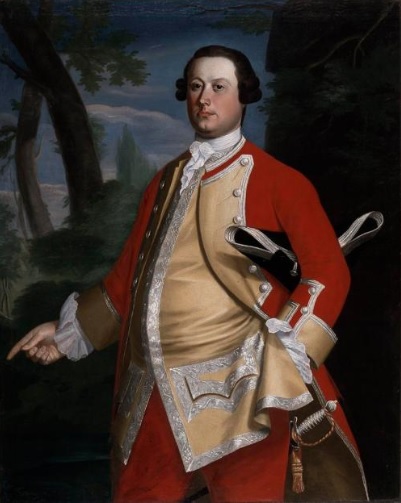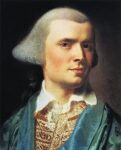
John Singleton Copley
American, 1738-1815 (active England)
Lieutenant Joshua Winslow, 1755
oil on canvas
50 7/8 × 40 3/8 in.
SBMA, Gift of Mrs. Sterling Morton for the Preston Morton Collection
1960.54

Self-Portrait, ca. 1769, Winterthur Museum, Garden and Library, Delaware
“Let me just recommend to you to keep the faces of your portraits as clear of shade as possible, and make broad masses of light and shade.” – John Singleton Copley
RESEARCH PAPER
John Singleton Copley was born in Boston on July 3, 1738, of Irish stock, the son of a proprietor of a tobacco shop. When he was about ten years old, his father died and his mother married Peter Pelham (1697-1751), a talented mezzotint engraver from England. It was through Pelham that Copley was first exposed to art as a career. "Perhaps more important was his stepfather's friendship with John Smibert (1688-1751), a Scottish artist who had become America's foremost portrait painter."
Copley's first works at the age of 15 appeared soon after the death of his stepfather in 1851. They were mezzotint engravings, some history paintings copied from prints and a few portraits in oil. "By 1755 he was putting out very competent likenesses, every bit as good as his older competitors. In a few more years he would eclipse all rivals."
Although he had overcome the difficulties of developing his talents in Colonial America without drawing schools, art collections or original works by famous masters to learn from, "he was the best portraitist the young colony produced in the eighteenth century," according to Robert Hughes writing for Time Magazine (Oct. 9, 1995) when the Metropolitan Museum of Art showed 75 works by Copley. He quotes Copley complaining about the lack of appreciation of art in America to his friend, Benjamin West, who was enjoying great success in London: "People regard it as no more than a useful trade, like that of a carpenter or shoemaker, not as one of the Noble arts of the world. Which is more than a little mortifying to me."
In 1765 through a friend, Copley sent his "Boy with a Squirrel" directly to Sir Joshua Reynolds in London, who urged him to come to Europe at once and West agreed. But, respected as Copley already was in his home city, he stayed on in Boston for nine more years, prospering from a clientele accessible through his marriage to Susannah Clarke, daughter of a Tory merchant representing East India Company's tea interests (the very tea dumped into the harbor during the Boston Tea Party).
With commissions likely to wane as the Revolution developed in 1774, Copley decided to pursue his ambition to move to London and enter the more respected realm of history painting in the grand manner of the age. He would never return again to the New World. His monumental works of those later years rivaled the best of his British contemporaries. He died in London, September 9, 1815.
In analyzing Copley's style, Hughes wrote: "We can now see Copley's work as the origin of the main lines of American painting: that empirical realism that, disdaining frills of style and "spiritual" grace notes, tried in all its sharpness (and occasionally bluntness) to engage the material world as an end in itself. Later figures in this line would be John James Audubon and Thomas Eakins. "But Copley was the first. He took the linear, enumerative style of American effigy painting and made it peculiarly grand. He did not edit out the warts and wens, the pinched New England lips, the sallow skin, the pockmarks that were the common disfigurements of the age before vaccination." Copley's clients liked his style because it was so embedded in the world of substance and inventories that had made them what they were."
Lieutenant Joshua Winslow
After a brief business career, Joshua Winslow (1727-1801) enlisted in the British army and served in the successful campaign of the British against the French stronghold on Cape Breton Island, Nova Scotia. In fourteen years he rose to the rank of captain. In 1759 he left the army and resumed his career as one of the consignees (along with Copley's father-in-law) chosen by the East India Company to sell tea and collect import duties. Winslow's allegiance to George III forced him to flee from Boston to Halifax, where he was a paymaster for the British forces.
The portrait of Joshua Winslow, painted when Copley was seventeen, reveals his formidable talent. It also represents his acceptance into the Patronage of social notables with commissions coming from the upper ranks of Boston society. Copley had learned so well by observing fellow artists that this portrait was for a very long time attributed to John Greenwood (1727-1792). In quite recent times, a cleaning revealed Copley's signature and the date, 1755.
The pose of Joshua Winslow has been traced to other American portraits. It is a fashionable pose from mid-century England that came to the colonies in mezzotint engravings. It is very likely that the young artist used such a print as his guide. The same pose is found in two later Copley portraits. His natural ability as an artist is shown in his rendering of the satin and brocade detailing of Winslow's waistcoat and the silvery piping of his hat and coat as well as the luster of his sword hilt.
Bibliography
Michael W. Schantz, The Preston Morton Collection of American Art Catalogue, The Santa Barbara Museum of Art, 1981, pp. 50-53
Robert Hughes, Time Magazine, Oct, 9, 1995, pp.73-74
Submitted to the Docent Council by Shirley Dettmann, n.d.
SBMA CURATORIAL LABELS
Painted when the aspiring Copley was just seventeen years old, this portrait already hints at his prodigious abilities, particularly in the description of fabrics, as in the Lieutenant’s embroidered vest. Copley’s step father (his Irish mother remarried after his father’s passing when he was just a boy) was an accomplished mezzotint engraver, which meant that Copley benefited from rigorous art instruction from an early age. In just a few short years, he would establish himself as the dominant portrait-painter in Boston, accruing wealth enough to marry into the elite of society, providing him with easy access to well-heeled clients. At the encouragement of ex-pat artist Benjamin West, who was President of the Royal Academy in England, Copley finally made the trip to Europe, settling in London in 1775, never to return to Boston. Though celebrated for his innovative realism as a portraitist, Copley also produced large-scale history paintings that rivaled those of Benjamin West in their ambition. He is considered the most talented American painter of the colonial period.
In the Boston period of his career, Copley’s sitters consisted of Tory and Whig alike. Winslow was a loyalist and served as an officer in the British forces, only fleeing the colonies right before the American Revolution. The pose he strikes was a convention among American portraitists, distantly related to 17th-century English prototypes.
https://collections.sbma.net/objects/1591/lieutenant-joshua-winslow
